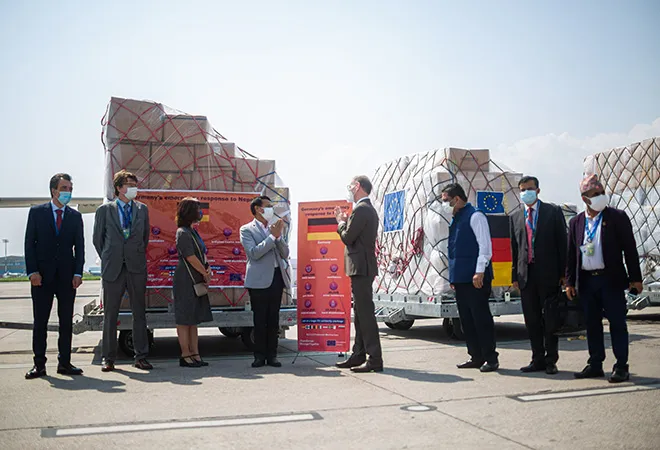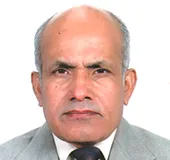
Nepal has been hit hard by COVID-19. Until a week ago, over 9,000 people in this Himalayan nation with a population of 30 million, were getting infected by the second wave and fatalities caused by this pandemic have crossed 200 deaths each day. Because of the lockdown imposed in most parts of the country for the last four weeks, the infection and fatality rates have somewhat declined but the situation continues to remain precarious.
As of May 26, 6,677 people breathed their last and over 540,000 people remained infected with this disease. Predictions are that 41,000 people could die by September end due to the pandemic in the country if the situation is not controlled.
No part of the country, including the Terai, the hills, and the mountain regions have spared. However, the Kathmandu Valley happens to be the main hotspot of the COVID-19 pandemic, where every day more than 100 bodies of COVID-19 victims are being cremated at Pashupati Aryaghat alone. The coronavirus pandemic has even engulfed the remotest of the remote rural areas of the country.
People in the country seem to be frustrated with the federal government for its failure to check the spread of COVID-19. There is hardly any effective coordination amongst the three wings of the government at the federal, provincial, and local levels. While the federal government accuses the provincial and local governments of not cooperating in the fight against the pandemic, the provincial and the local governments complain of lack of financial and other necessary support from the federal government as the main bottleneck for their non-performance.
People in the country seem to be frustrated with the federal government for its failure to check the spread of COVID-19. There is hardly any effective coordination amongst the three wings of the government at the federal, provincial, and local levels. While the federal government accuses the provincial and local governments of not cooperating in the fight against the pandemic, the provincial and the local governments complain of lack of financial and other necessary support from the federal government as the main bottleneck for their non-performance.
Though the second wave was peaking in Nepal’s neighbourhood, including Delhi and other states in India in March-April, the Nepalese government remained complacent and contributed very little to increase oxygen supply, ventilators, and make other arrangements to control the possible rise in coronavirus cases in the country. Even in such a situation, the cases would not have worsened had the government’s inoculation programme run smoothly. Nepal was one of the first few countries in the world that initiated its inoculation programme as early as January this year.
Though the second wave was peaking in Nepal’s neighbourhood, including Delhi and other states in India in March-April, the Nepalese government remained complacent and contributed very little to increase oxygen supply, ventilators, and make other arrangements to control the possible rise in coronavirus cases in the country
The vaccination programme in Nepal started with one million doses of the AstraZeneca Covishield vaccine, which the country received from India under grant assistance. The Nepalese military also received 100,000 doses of the same vaccine under a grant scheme from India. Furthermore, Nepal received 348,000 doses of Covishield from India under the COVAX facility.
Subsequently, Nepal ordered two million doses of Covishield from India’s Pune-based Serum Institute of India (SII); of which, it could receive only one million doses. The country could not get the supply of another one million doses of the vaccine as exports from the SII stopped amidst the growing demand for the vaccine within India itself.
Nepal’s failure to get the needed supply of Covishield vaccine from India has made the situation chaotic. The severity of the situation is known from the fact that the 13 million senior citizens of 65+ age have not been able to receive the second dose of this vaccine even after 12 weeks. Now the government is mulling over giving a second dose of Covishield after 12 to 16 weeks.
Nepal’s failure to get the needed supply of Covishield vaccine from India has made the situation chaotic. The severity of the situation is known from the fact that the 13 million senior citizens of 65+ age have not been able to receive the second dose of this vaccine even after 12 weeks. Now the government is mulling over giving a second dose of Covishield after 12 to 16 weeks.
In such a time of national health crisis, Nepal’s Prime Minister KP Shama Oli appealed to the international community to help the country in combating the COVID-19 pandemic. Also, the country used its diplomatic missions abroad to convince the international community to give much-needed medical support to Nepal.
Understanding the seriousness of the situation in Nepal, the Executive Director of the World Health Organiaation (WHO) stated that Nepal needed immediate emergency support to control the epidemic. Accordingly, the US government extended the first batch of emergency aid through its United States Agency for International Development (USAID), which included 100 units of ventilators, COVID-19 testing equipment, oxygen-related materials, and personal protection equipment (PPEs).
Chinese President Xi Jinping announced the supply of one million doses of COVID-19 vaccines to Nepal under grant assistance. Besides, the Tibet Autonomous Region of China provided 800 filled oxygen cylinders, 10 oxygen concentrators, five ventilators, 200 ICU beds and 15,000 antigen kits to Nepal. Earlier on, China had also supplied 8,000 doses of Vero Cell vaccines to this country in grants.
In its first consignment, Singapore supplied 13 tons of medical equipment, including ventilators, Bi-Pap systems, and pulse oximeters, PCR test kits and swabs, RNA extraction machines, and certain relief materials to Nepal.
Switzerland extended 30 tons of medical supplies to Nepal, including 40 ventilators, oxygen concentrators, 1.1 million rapid antigen test kits and PPEs worth US $8 million.
The United Nations under the Nepal COVID-19 Response Plan is likely to provide US $83.7 million in emergency relief for the next three months in support of 750,000 people belonging to vulnerable groups in the country. Similarly, the European Union (EU) has granted 75 million euro in aid package to this country.
Organisations in Spain supplied 50 oxygen cylinders, 10 oxygen concentrators, and 15 ventilators, apart from other medical kits. Additionally, countries including Finland, France, Germany, and Belgium donated 50 oxygen cylinders, 20 concentrators. 77 ventilators, 14 respirators, 164,000 antigen tests, 3.4 million masks, 42,500 gloves, 30,000 isolation gowns, and 20,000 oxygen cannula to Nepal. Moreover, Britain, Australia and New Zealand are also committed to supporting health materials in this country.
Although Nepal received so much medical supplies from the international community, there is still an acute shortage of oxygen, hospital beds, intensive care unit beds, ventilators, and critical care medicines. What is worrying is that the country does not have adequate critical care experts for the treatment of infected patients. As such in certain hospitals, health equipment like ventilators have not been brought into operation on account of the lack of anesthesiologists.
Significantly, different bilateral and multilateral agencies have responded positively towards Nepal’s call for support to fight the COVID-19 pandemic, but the country has not yet been able to receive any additional doses of vaccines from any quarter of the world other than what was initially supplied by India and China. Experts believe that it is the vaccines that could save the lives of people more, though the importance of other medical supplies cannot be overlooked.
Different bilateral and multilateral agencies have responded positively towards Nepal’s call for support to fight the COVID-19 pandemic, but the country has not yet been able to receive any additional doses of vaccines from any quarter of the world other than what was initially supplied by India and China
The international community and particularly India’s role in Nepal’s neighbourhood becomes all the more important to save the nation from the crisis by providing vaccines, apart from the critical care experts and other medical supplies. If it is not done, certain country/countries could take advantage of the situation and aggressively enter into Nepal under the garb of supporting the country in its fight against COVID-19. Such a situation might be embarrassing for India, which, until now, has earned a large amount of goodwill in this country. Also, considering the open border system between Nepal and India, India will not remain safe until COVID-19 is controlled in Nepal. So, the need of the hour for India is to accord national treatment to Nepalese by providing the required doses of vaccines and other medical supplies.
The views expressed above belong to the author(s). ORF research and analyses now available on Telegram! Click here to access our curated content — blogs, longforms and interviews.




 PREV
PREV


